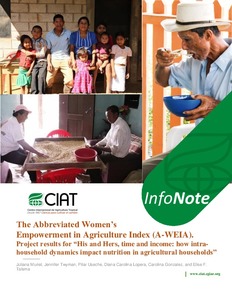The Abbreviated Women’s Empowerment in Agriculture Index (A-WEIA). Project results for “His and Hers, time and income: How intra-household dynamics impact nutrition in agricultural households”.
Abstract
Interest in understanding the inequalities between rural men and women, and in particular, the obstacles and limitations that women face in order to have greater inclusion in the agricultural sector, has generated the need to construct empowerment indicators which enable analysts to identify actions oriented towards the attainment of gender equity.
The Abbreviated Women’s Empowerment in Agriculture Index (A-WEIA) is such an indicator, created by the International Food Policy Research Institute (IFRPI), which measures the degree of participation of women and men in the agricultural sector in five domains: 1) input in agricultural production decisions, 2) access and decision-making power over productive resources, 3) control over the use of income, 4) leadership in the community and 5) time allocation.
This Info Note applies the A-WEIA to a sample of Guatemalan agricultural households and shows how this index can be used in this context, in order to analyze the degree to which women and men are empowered in their homes and the degree of inequality between women and men within the same household. This application is framed within the project “His and Hers, time and income: How intra-household dynamics impact nutrition in agricultural households,” led by the International Center for Tropical Agriculture (CIAT) and the University of Florida1 with funding from the program Innovative Methods and Metrics for Agriculture and Nutrition Actions (IMMANA).

